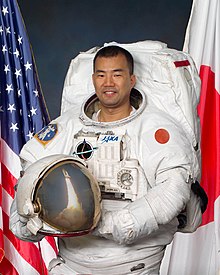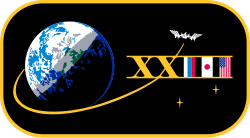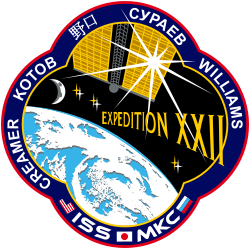Soichi Noguchi
| Soichi Noguchi (野口聡一) | |
 Soichi Noguchi | |
| Född | 15 april 1965 Yokohama, Japan |
|---|---|
| Tid i rymden | 344 dagar, 9 timmar, 33 minuter |
| Uppdrag | STS-114, Sojuz TMA-17, Expedition 22/23, SpaceX Crew-1, Expedition 64 |
| Uppdragsemblem | |
Soichi Noguchi(japanska: 野口聡一?, Noguchi Soichi ), född 15 april 1965 i Yokohama, Japan, är en japansk astronaut och ingenjör för flyg- och rymdteknik.
Den 26 juli 2005 deltog han i expeditionen STS-114 med rymdfärjan Discovery som var den första amerikanska flygningen efter Columbia-katastrofen. Expeditionen var tillbaka den 9 augusti samma år.
Han var även med i expeditionen Sojuz TMA-17, från 20 december 2009 till 2 juni 2010, som var en del av det ryska rymdprogrammet.
Den 16 november 2020 sköts han upp med SpaceX Crew-1 för att delta i Expedition 64.
Asteroiden 5734 Noguchi är uppkallad efter honom.[1]
Referenser
- Den här artikeln är helt eller delvis baserad på material från engelskspråkiga Wikipedia, 10 oktober 2014.
- ^ ”Minor Planet Center 5734 Noguchi” (på engelska). Minor Planet Center. https://www.minorplanetcenter.net/db_search/show_object?object_id=5734. Läst 6 november 2019.
|
Media som används på denna webbplats
The focal point of the Expedition XXIII emblem illustrates the beautiful planet Earth in the black expanse of space. The International Space Station (ISS) is shown traveling in its orbit around Earth. The ISS orbital path flies through the XXIII to show that this increment is building upon the missions that have gone on before and laying the groundwork for future missions. This illustrates the work being performed aboard the orbiting complex that will lead the way to eventual missions to the moon, Mars and beyond. The mission designation uses Roman numerals to illustrate the home nations of the crew, which are also represented by their national flags. The two stars represent the two teams that make up this expedition crew.
International Space Station (ISS) Expedition 64 mission insignia
- The Expedition 64 patch shows the International Space Station illuminated by the city lights of earth. The illumination of the space station modules represents the enduring partnership and continuous human presence on station for 20 years. The modules from all partner countries represent the international cooperation, which sustains this presence in space. The aurora and light behind the horizon are beautiful features of our home planet, and the Moon and stars in the background shows our future exploration beyond Earth.
Emblem of Nasa's STS-114 mission.
- The STS-114 patch design signifies the return of the Space Shuttle to flight and honors the memory of the STS-107 Columbia crew. The blue Shuttle rising above Earth’s horizon includes the Columba constellation of seven stars, echoing the STS-107 patch and commemorating the seven members of that mission. The crew of STS-114 will carry the memory of their friends on Columbia and the legacy of their mission back into Earth orbit. The dominant design element of the STS-114 patch is the planet Earth, which represents the unity and dedication of the many people whose efforts allow the Shuttle to safely return to flight. Against the background of the Earth at night, the blue orbit represents the International Space Station (ISS), with the EVA crewmembers named on the orbit. The red sun on the orbit signifies the contributions of the Japanese Space Agency to the mission and to the ISS program. The multi-colored Shuttle plume represents the broad spectrum of challenges for this mission, including Shuttle inspection and repair experiments, and International Space Station re-supply and repair.
The 22nd Expedition to the International Space Station is dedicated to the final stages of assembly and the transition to full utilization as an orbiting laboratory. The sun, providing power and life support to the space station, shines through one of the solar arrays as the ISS orbits above Earth. The oceans and atmosphere, providing life support to Earth, are shown in all their beauty. The moon hovers in the distance as the goal of the next era of exploration. The six stars illustrate the increased capability of the crew complement. In the border are the national flags of the crew members as well as their surnames in their native languages. Expedition XXII continues the effort to acquire the knowledge necessary to extend the reach of exploration from Earth, to the moon and beyond.





